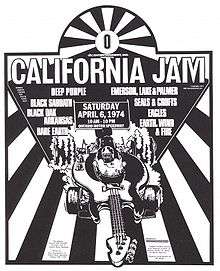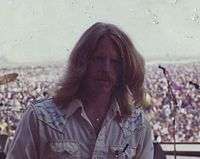California Jam
| California Jam | |
|---|---|
 California Jam 1974 | |
| Genre | Hard rock, progressive rock, heavy metal |
| Dates | April 6, 1974 |
| Location(s) | Ontario, California, USA |
| Founded by | ABC Entertainment, Sandy Feldman and Leonard Stogel |
| Attendance | 250,000 (tickets sold) |
California Jam (also known as Cal Jam) was a rock music festival co-headlined by Deep Purple and Emerson, Lake & Palmer, held at the Ontario Motor Speedway in Ontario, California, on April 6, 1974. It was produced by ABC Entertainment, Sandy Feldman and Leonard Stogel.[1] Pacific Presentations, a Los Angeles-based concert company headed by Sepp Donahower and Gary Perkins, coordinated the event, booked all the talent and ran the advertising. Don Branker[2] worked for Leonard Stogel and was responsible for concert site facilitation, toilets, fencing and medical. It attracted 300,000-400,000[2] paying fans. The festival set what were then records for the loudest amplification system ever installed, the highest paid attendance, and highest gross in history. It was the last of the original wave of rock festivals, as well as one of the most well-executed and financially successful, and presaged the era of media consolidation and the corporatization of the rock music industry.
Performers
Acts that performed at the festival in order of appearance:
- Rare Earth
- Earth, Wind & Fire
- Eagles
- Seals and Crofts
- Black Oak Arkansas
- Black Sabbath
- Deep Purple
- Emerson, Lake & Palmer
Deep Purple's performance was one of the first with their third line-up, which included the vocalist David Coverdale and the vocalist/bassist Glenn Hughes. Deep Purple was given the choice of when to go on stage, and chose to go on during sunset, thus pushing Emerson, Lake & Palmer to the last performance. Assuming that, as with all festivals, the show would run late anyway, they stalled when the festival was actually ahead of schedule. Angry organizers tried to force the band to go on and then threatened to cancel their performance but a quick thinking announcer told the crowds that Deep Purple would be coming on. The band made everyone wait nearly an hour until near dusk before they went on stage. In spite of this, the show did not end up running late.[3] At the end of the show, guitarist Ritchie Blackmore threw a number of guitars, amplifier and speaker cabinets out into the audience and attacked one of the network's video cameras (which had been getting between him and the audience) with a guitar. Later on, a mishap with a pyrotechnic effect caused one of Blackmore's amplifiers to explode, which briefly set the stage on fire. The group had to leave the concert by helicopter to avoid a possibly ugly confrontation with furious fire marshals and ABC-TV executives (and potential arrest for the pyrotechnics). The damage to the camera was estimated to be $10,000, later settled by the managers.
The weather on the day of the concert was unusually hot for that time of year. At one point in the afternoon, thousands of plastic gallon jugs were handed out to the audience, who were able to fill them up at the many drinking fountains that had been set up on the grounds. During the prolonged delay waiting for Deep Purple to hit the stage, restless concert goers began tossing the jugs in the air. More and more of the audience joined in until the air above the crowd was filled with thousands of water jugs flying around, spraying water over everyone.
Deep Purple's California Jam performance, along with some of the performances by other bands, was broadcast on TV and radio nationwide in the US. It was at this festival that the footage of Keith Emerson playing a grand piano spinning end-over-end 50 feet above the ground was taken.
Attendance and technology

The concert set a record for the largest paid attendance at such an event. Although more people attended the festival at Woodstock in New York, only a few thousand had purchased tickets.
Another record established at California Jam was for the largest (most powerful) concert sound system ever assembled, particularly from the demands of Deep Purple, who were identified as the "loudest band in the world" by the Guinness Book of World Records. Tycobrahe Sound Company combined the touring systems of Deep Purple, Black Oak Arkansas, Black Sabbath, Earth Wind and Fire, and Rare Earth (each manufactured by Tycobrahe), plus 16 feet (4.9 m) bass horns from Phoenix Sound and several folded bass horns from Flag Systems. Total power was 54,000 watts RMS, provided by a number of BFA-2000 amplifiers, manufactured by Tycobrahe.
The Goodyear blimp hovering overhead was a first for a music festival. Deep Purple arrived for the concert in their own chartered jet, the Starship, with their name painted on the plane's sides, the first time a major band arrived specifically for a music festival in their own plane.
Another first was the setting of the stage sets for each band on rails, allowing rapid changeover to the next band, thus eliminating delays and allowing the rock festival to run on time; in fact, ahead of time.
Emerson, Lake and Palmer's touring sound system was set up about half a mile from the stage and timed with a tape delay to coincide with the sound from the stage.
Broadcast, telecast and record releases
Unlike other rock festivals such as Woodstock, the concert was not planned for release as a film or sound recording. However, the ABC television network (which was also a sponsor of the concert) broadcast several portions of the show as part of its In Concert series several months later. The audio portion of the show was also broadcast in stereo on FM radio stations, an early example of simulcasting. KMET FM Promoted and broadcast the concert around Los Angeles.
Deep Purple's California Jam performance was the first full-length music concert film to be released and sold on video tape in the early 1980s.
Several performances from the show were eventually released on CD and video, both in bootleg and authorized form. One of the more notable bootleg recordings was from a fan who tried to pass off his recordings of a recording from the radio broadcast as something he created. His web site was shut down after he tried selling his unauthorized products without creative approval from the artists involved and the producers of the festival.
Authorized releases include:
- California Jamming, CD of Deep Purple's performance (also released under alternate titles)
- Live in California 74, DVD of Deep Purple's performance
- Beyond the Beginning, Emerson, Lake & Palmer DVD including 44 minutes of their California Jam performance
Cultural impact
A sequel concert, California Jam II, was held March 18, 1978.
See also
References
- ↑ Stu Beitler (May 25, 1979). "Chicago, IL Jumbo Jet crashes on take off, May 1979". gendisasters.com. Retrieved 23 July 2013.
- 1 2 donbranker.com
- ↑ Moody, James (1997). Concert Lighting, Second Edition: Techniques, Art and Business (2nd ed.). Focal Press. p. 67. ISBN 978-0-240-80293-0.
External links
- The Official califorinajamfanclub.
 Media related to California Jam at Wikimedia Commons
Media related to California Jam at Wikimedia Commons